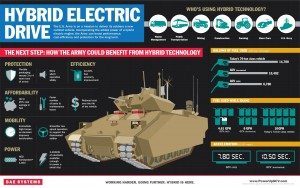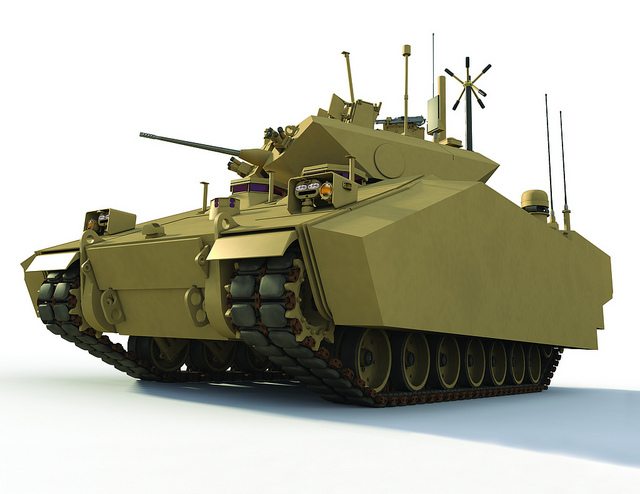BAE Systems has released an infographic outlining the features of its hybrid Ground Combat Vehicle (GCV). A joint venture between BAE Systems and Northrop Grumman with other partners, the GCV proposal is part of a US Army competition to replace the Bradley Fighting Vehicle, which entered service in 1981.
The BAE/Northrop Grumman GCV is one of a number of proposals intended to replace the Bradley within seven years. Like the Bradley, the GCV is an armored troop transport intended to quickly move soldiers into a combat zone and provide support fire. This particular design was created from the ground up and is intended to be upgradable, with a projected service life for the technology of up to 40 years.
The GCV carries three crew and nine squad members inside its steel-core hull and boasts an integrated electronic network capability and embedded intelligence, surveillance and reconnaissance equipment. However, the centerpiece of the vehicle is its simplified drive train. The GCV is propelled by an Hybrid Electric Drive (HED) developed by the partnership. It puts out 1,100 kW of electricity, has fewer components, and lower volume and weight than current power plants. Being an electric drive, it generates high torque at start, smoother low-speed operation and can run silently – an advantage in night operations.
The partnership makes a big thing of the GCV’s 20 percent fuel savings while running – additionally, however, it burns only 4.61 gallons (17,45 liters) per hour while idling, as opposed to 10 gallons (37.85 liters) per hour for a 70-ton vehicle. This idling rating is important, because military vehicles spend a lot of time sitting still while powering the electronics. Unfortunately, this hybrid still isn’t exactly a fuel sipper, at only 0.73 mpg (322 l/100km). Its top speed is 43 mph (70 km/h) and it can do 0 to 20 mph (32.18 km/hr) in 7.8 seconds.
One drawback of the GCV in its current design is that it’s almost twice as heavy as the Bradley, with a vehicle weight of 70 tons (63.5 tonnes) compared to the Bradley’s 30.4 tons (27.5 tonnes). This is due in part to the GCV carrying three more squad members, but mostly to the need to provide full protection for crew and squad. This meant extra armor – enough to provide more protection than a RG-33 Mine-Resistant Ambush Protected vehicle. Unfortunately, the Pentagon didn’t specify a weight limit in its Request for Proposal (RFP), so the GCV came out a bit on the heavy side.
The budgeted cost for the GCV is set at US$13 million per vehicle.











